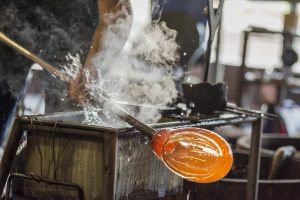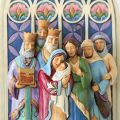Since I was a little girl, I’ve been fascinated by handblown glass and glassblowers. Glassblowers are fascinating artists. This week I’ve been watching a show where glassblowers compete for scholarship money. They are given a specific assignment with a time limit to make some piece of glass. The artists then use their own creative powers to make the piece interesting, unique, and beautiful. At any moment in the process, this gorgeous creation can break and shatter to the floor. The slightest little tap with a tool in the wrong place, a variation in heat, or a simple distraction to the artist, and the whole thing is dropped and ruined. The glassblower must begin again.
 Testimonies can be as fragile as handblown glass. We are excited as the Holy Ghost bears witness of truth, and our testimony begins to grow. We read the scriptures, pray, attend church, and accept callings and assignments. Our testimony strengthens. With our human frailties, we get distracted and don’t read the scriptures. A tiny stress fracture appears in our testimony unseen by the naked eye. We forget to pray, and another stress fracture is produced. We become complacent in living the commandments, producing yet another tiny fracture. Satan is then able to intervene with a simple distraction to shatter our gorgeous piece of handblown glass. Sometimes he uses worldly distractions, such as money or power. Other times, he uses our need for the approval of our peers. He sometimes distracts us with unpleasant things in church history, or the failings of men. He knows our weak spots and uses them to his advantage. Those tiny stress fractures cause our testimonies to shatter.
Testimonies can be as fragile as handblown glass. We are excited as the Holy Ghost bears witness of truth, and our testimony begins to grow. We read the scriptures, pray, attend church, and accept callings and assignments. Our testimony strengthens. With our human frailties, we get distracted and don’t read the scriptures. A tiny stress fracture appears in our testimony unseen by the naked eye. We forget to pray, and another stress fracture is produced. We become complacent in living the commandments, producing yet another tiny fracture. Satan is then able to intervene with a simple distraction to shatter our gorgeous piece of handblown glass. Sometimes he uses worldly distractions, such as money or power. Other times, he uses our need for the approval of our peers. He sometimes distracts us with unpleasant things in church history, or the failings of men. He knows our weak spots and uses them to his advantage. Those tiny stress fractures cause our testimonies to shatter.
When handblown glass shatters and hits the floor, the glassblower picks up the tools and begins again. There is no hesitation, as glassblowers are committed to their craft. They don’t give up on a beautiful creation because their first, second, even tenth attempt is swept from the floor. They simply begin anew—with fresh determination to stay focused so they can complete the piece.
Repentance gives us the chance to sweep the shattered glass from the floor and begin anew. Christ’s Atonement has already paid for all that shattered glass. He has given us the tools to create the most gorgeous piece of art we can imagine. He never takes away those tools. No matter how many times we shatter our own testimonies, we have the tools to start from scratch and begin again.
Unlike glass that always remains fragile even after it is a complete, beautiful piece, testimonies can be built strong enough to thwart breakage. As we stay on the covenant path, read scriptures daily, pray, attend church, and live the commandments, our testimonies continue to get stronger. As long as we continue to do these things, Satan has a hard time distracting us, and our testimonies become strong as iron. Even so, we must always be mindful and on guard—even iron melts at 2,800 degrees Fahrenheit (1,537.778 degrees Celcius). Tempered glass is four times stronger than regular glass because it is cooled slowly. Car windshields are made of tempered glass, but can be shattered easily with a baseball bat. It takes much more than a baseball bat to damage an iron beam. Constant and vigilant attention can make testimony as break-resistant as an iron beam.
“[L]ike a growing plant, [testimony] must be nurtured or it will wither. Frequent and heartfelt prayers of faith are crucial and needed nutrients. Obedience to the truth you have received will keep the testimony alive and strengthen it. Obedience to the commandments is part of the nourishment you must provide for your testimony. …
Testimony requires the nurturing by the prayer of faith, the hungering for the word of God in the scriptures, and the obedience to the truth we have received. There is danger in neglecting prayer. There is danger to our testimony in only casual study and reading of the scriptures. They are necessary nutrients for our testimony” (Henry B. Eyring, “A Living Testimony,” Apr. 2011 General Conference).
Just as a molten blob gathered on the end of the blowpipe needs air bubbles to inflate and expand the blob into the size desired, the faith seed of testimony needs prayer, study, and work to transform it into hardened testimony and true conversion. The molten blob is then transferred to a steel or iron rod called a punty so it can be shaped and formed. Testimony is further shaped and formed as we take newfound knowledge and use it for good. As we serve others, we become more like Christ and testimony becomes conversion.
As a glassblower works with a molten blob, it begins to cool. In order to keep the glass hot enough to be pliable, he/she puts the blob into a second furnace called a “glory hole” which reheats the glass for further shaping and forming. Each time we open our scriptures, attend sacrament meeting, or kneel in prayer, we subject our testimony to the glory hole for reheating.

To read more of Tudie’s articles, click here.
Once a piece of glass art is complete, it is placed in a third furnace called an annealer, which allows the piece to cool slowly over hours or even days to avoid thermal stress from cracking or shattering the piece. Come, Follow Me, Family Home Evening, singing hymns, journal writing, family history work, and temple attendance place testimony in the annealer to keep it from cracking or shattering.
As I’ve learned more about handblown glass and the artists who create it, I’ve learned that testimony is a living, growing thing. It needs constant attention—nourishment, as President Eyring put it. It is heated, molded, reheated, remolded, completed, and slowly cooled over a lifetime. Testimony and true conversion require hard work in a hard environment. Just as the glassblower’s shop is hot and exhausting, life is equally hard and oppressing. If we endure it well, the art created is a beautiful testimony that sustains us until we are returned to our Heavenly Father.
About Tudie Rose
Tudie Rose is a mother of four and grandmother of ten in Sacramento, California. You can find her on Twitter as @TudieRose. She blogs as Tudie Rose at http://potrackrose.wordpress.com. She has written articles for Familius. You will find a Tudie Rose essay in Lessons from My Parents, Michele Robbins, Familius 2013, at http://www.familius.com/lessons-from-my-parents.
Twitter •






